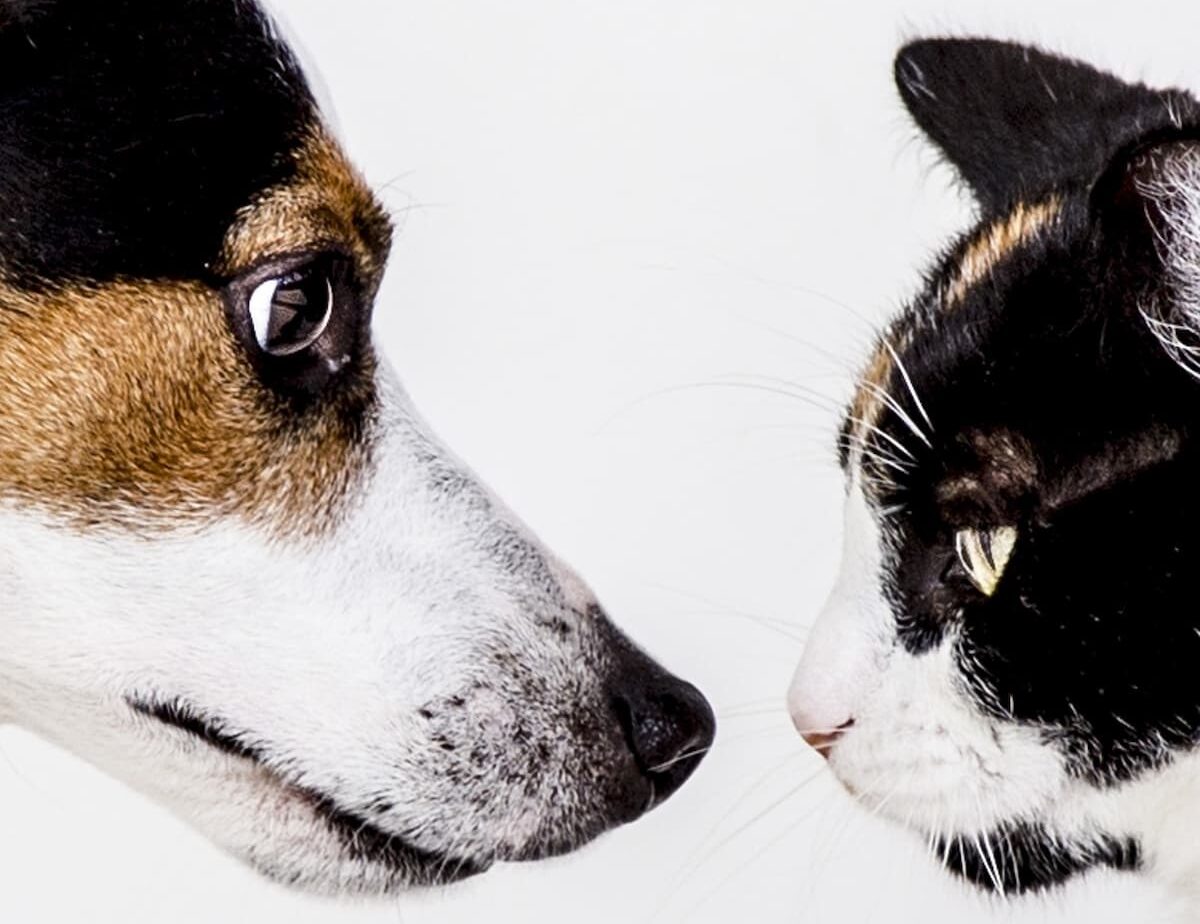Picture this: A peaceful, sun-drenched afternoon in the suburbs.
Not a cloud in sight, the gentle breeze rustling leaves and stirring the colorful flowers that adorn each picket-fenced yard.
Your dog busy relaxing on the lawn, until an unsuspecting cat passes by.
All of a sudden, your dog makes a dash towards the feline, chasing it across the fence.
It’s a rivalry as old as time and this article will answer the age-old question: Why do dogs chase cats?
Why do Dogs Chase After Cats?
Dogs and cats are known to have a complicated relationship, often depicted as being at odds with each other.
One common behavior that many dog owners have observed is their dog’s inclination to chase after cats.
There are many reasons behind this behavior:
Predatory Instincts
Dogs, as descendants of wolves, are natural predators.
Their ancestors relied on hunting for survival, and their instincts have been passed down through generations.
When a dog sees a cat darting across their line of vision, their predatory instincts kick in, triggering an intense urge to chase.
It’s like a game for them – the thrill of the chase activates their inner predator mode.
Motion Triggers
Dogs are often drawn to moving objects, and cats’ quick and agile movements are like magnets to them.
The swift, unpredictable motion of a cat triggers a dog’s prey drive, making them unable to resist the temptation.
In their eyes, it’s a perfect opportunity for a fun-filled pursuit, satisfying their inherent need for physical exercise and mental stimulation.
Scent-based Curiosity
Dogs have an incredible sense of smell, far superior to humans.
Cats possess distinct pheromones that pique a dog’s curiosity and, in turn, fuel their desire to chase.
The lingering scent left behind by a cat can be irresistible for a dog, compelling them to track down its origin.
It’s a game of hide-and-seek, driven by their heightened sense of smell combined with their natural inquisitiveness.
Territorial Instincts
Dogs are instinctively territorial creatures, so they naturally want to protect their space and keep potential threats away.
This territorial behavior stems from their ancestry as pack animals.
In the wild, dogs establish and defend their territory to ensure their survival.
This territorial instinct is often triggered when they encounter other animals, such as cats, intruding into their perceived domain.
Behavioral Differences
Another factor that contributes to the chase is the difference in behavior between dogs and cats.
Cats are generally more independent and elusive, while dogs are social animals that thrive on interaction and play.
When a dog sees a cat running away, it triggers their prey drive, and they see it as an opportunity for social engagement or play.
This natural drive to pursue and capture their perceived playmate is what leads dogs to chase after cats.
While dogs chasing cats may be instinctual, it is possible to train your pups to co-exist peacefully with felines especially at an early age:
Early Training
Early training plays a crucial role in teaching dogs how to appropriately respond to cats.
By exposing puppies to cats in a controlled and supervised environment from a young age, we can help them develop positive associations and behaviors.
This can include rewarding the dog for calm and indifferent behavior around cats, as well as teaching basic commands like “leave it” or “stay.”
Consistency and repetition are key when training a dog to resist their natural instinct.
With time, patience, and positive reinforcement, dogs can learn to control their urge to go after cats.
Desensitization
Another effective method to control a dog’s urge to go after cats is through desensitization and counterconditioning techniques.
This involves gradually exposing the dog to cats in a controlled manner, starting from a distance and progressively reducing the distance over time.
The idea is to help the dog associate the presence of cats with positive experiences, such as treats, praise, or playtime.
By gradually increasing the dog’s exposure and rewarding calm behavior, we can help them overcome their instinct to chase cats.
It is important to note that this process should always be done under the guidance of a professional trainer or behaviorist.
Techniques to Train Dogs to Peacefully Interact with Cats
Even older dogs can be trained to peacefully interact with cats provided you follow the right techniques:
Creating a positive association
The first technique to train dogs to peacefully interact with cats is to create a positive association between the two animals.
Start by keeping them separated and allowing them to get used to each other’s scents.
You can exchange bedding or use treats to reward them for calm behavior when they are near each other.
Gradually, start supervised interactions by using a baby gate or a leash on both animals.
Allow them to see, sniff, and approach each other while keeping them physically separated.
Provide rewards and praise for calm and friendly behavior.
Over time, as they become more comfortable, you can increase the duration and frequency of their interactions.
Teaching commands and boundaries
Another important technique is to teach your dog basic commands, such as “sit,” “stay,” and “leave it.”
These commands will help establish boundaries and control their behavior when they are around cats.
Practice these commands in a controlled environment before introducing the cat.
When your dog successfully follows the commands, reward them with treats and praise.
This positive reinforcement will help them understand what is expected of them and make the association that good behavior leads to rewards.
Establishing boundaries
Create separate spaces for your pets, such as designated sleeping areas or feeding stations.
This not only gives them their own safe haven but also reduces the opportunity for territorial disputes.
Providing each pet with their own toys and resources also helps prevent conflicts over possessions.
Remember, every pet is unique, and it’s essential to observe and understand your individual dog’s behavior.
Some dogs may need more time and patience to adjust to living harmoniously with cats.
Consistency is also key, so continue training sessions regularly and reinforce positive behavior whenever your dog is around cats.
Over time, they will learn to peacefully coexist and even enjoy each other’s company.
FAQ
Q: Do dogs chase cats because of their natural instincts?
A: Absolutely!
While dogs and cats can be best pals, deep down, dogs have an innate chasing instinct.
It’s a remnant from their wild ancestry when their ancestors roamed free and hunted for survival.
So, when they spot a frisky feline frolicking by, their instincts kick in, making them want to give chase.
Q: Do they truly see cats as prey?
A: Well, not necessarily in the sense of a tasty meal.
Unlike true predators, dogs, especially domesticated ones, usually view cats more as a moving target rather than dinner.
It’s like their playful side takes over, triggering that insatiable desire to give chase.
Think of it as an exciting game of ”catch me if you can”!
Q: What about dogs that grow up with cats?
A: Ah, those lucky dogs who grew up in the company of cats!
While living together might dampen their wild instincts to some extent, the chasing behavior can still persist.
Dogs often chase out of curiosity, playfulness, or even jealousy over the attention their feline companions receive.
It’s like they’re saying, “Hey, why are you getting all the cuddles and strokes? Pay attention to me too!”
Q: Can this chasing behavior be controlled?
A: Absolutely, yes!
With proper training and socialization, we can get our four-legged friends to understand that chasing cats is a big no-no.
Teaching basic obedience commands like “leave it” or “stay” can help redirect their attention when a cat enters the scene.
Additionally, exposing dogs to well-behaved cats from an early age can help foster a more harmonious relationship between the two furry species.
Q: What about small dogs chasing cats?
Is it the same story?
A: You bet!
The size of a dog doesn’t really matter when it comes to chasing cats.
Small dog breeds can be equally eager to give chase, if not more so, because they might feel the need to compensate for their diminutive stature.
It’s as if they’re trying to prove that size is not an obstacle when it comes to being a top-notch chaser!
Q: Are all dogs prone to chasing cats?
A: While chasing is a common behavior among dogs, not all of them are automatically inclined to go after cats.
Each dog has its own unique personality and upbringing that can influence their reactions.
Some dogs are simply uninterested or indifferent towards cats, while others might be scared or anxious around them.
So, it’s not a hard and fast rule that all dogs are natural-born cat-chasers.
Q: Can cats and dogs ever become best buddies?
A: Absolutely!
Cats and dogs have been known to develop deep and loving friendships.
With patience, proper introductions, and gentle encouragement, they can learn to coexist peacefully or even form a close bond.
Gradually exposing them to each other’s scents, rewarding positive interactions, and providing a safe and quiet space for them to retreat can help foster a harmonious and loving relationship between our favorite pets.
Q: Should I be worried about my dog chasing cats in the neighborhood?
A: While it’s important to acknowledge the chasing instinct of dogs, it’s crucial to keep them under control when encountering cats in the neighborhood.
Not all cats will appreciate a doggy pursuit, and it can lead to stress, fights, or even accidents.
Keep your dog on a leash or ensure they are in a secure, fenced area when around unfamiliar cats to avoid any mishaps.
Remember, a little caution goes a long way to keep everyone safe and happy, both cats and dogs alike!
Whether your dog loves to chase cats or has become best buddies with one, the relationship between these two furry companions will always hold an air of playfulness, curiosity, and occasional mischief.
To Conclude
Dogs and cats have been at odds since time immemorial, driven by instinct and their unique ways of communication.
While dogs may have evolved from their wild ancestors, that primal urge to chase is still engrained in their nature.
Remember, though, that not all dogs chase cats. Many can live in harmony with their feline counterparts, proving that nurture can truly triumph over nature.
Proper socialization, training, and a loving environment are key to promote a peaceful coexistence.
And let’s not forget that every dog is an individual, with their own personality traits and quirks.
So, the next time your fluffy companion sets their sights on a cat, take a moment to understand that it’s not personal.
It’s just their canine instincts taking the lead.
Of course, it’s equally important to ensure the safety and well-being of all animals involved, avoiding any situations that could put them at risk.














